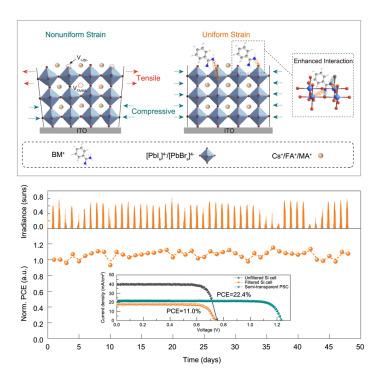Homogenizing strain via reinforced lattice interaction enables efficient and stable 4T perovskite/silicon tandem solar cells
IF 35.4
1区 材料科学
Q1 CHEMISTRY, PHYSICAL
引用次数: 0
Abstract
Connecting a wide-band-gap (WBG) perovskite solar cell with a crystalline silicon (c-Si) cell enables the device to surpass the Shockley-Queisser (S-Q) limit of a single-junction solar cell. However, strain in WBG perovskites reduces the ion migration barrier and defect formation energy, severely impacting the efficiency and stability of tandem devices. Herein, we utilize benzamidinium chloride (BMCl), a molecule containing a deprotonation-resistant amidinium group, which occupies the A-site vacancy and interacts strongly with the [PbI6]4− octahedra to stabilize the crystal lattice. This strategy synergistically facilitates uniform compressive strain formation within perovskite films, increasing the ion migration barrier and defect formation energy. The optimized WBG single-junction perovskite (with a 1.67 eV band gap) and 4-terminal (4T) perovskite/Si tandem devices achieved power conversion efficiencies (PCEs) of 23.5% (22.9% certified) and 33.4%, respectively. Remarkably, the 4T tandem device showed no PCE decay after 48 days of operation under outdoor conditions, demonstrating superior real-world stability.

通过增强晶格相互作用使应变均匀化,使4T钙钛矿/硅串联太阳能电池高效稳定
将宽带隙(WBG)钙钛矿太阳能电池与晶体硅(c-Si)电池连接,使该设备能够超越单结太阳能电池的Shockley-Queisser (S-Q)极限。然而,WBG钙钛矿中的应变降低了离子迁移势垒和缺陷形成能量,严重影响了串联器件的效率和稳定性。在这里,我们利用了氯化苄脒(BMCl),一种含有抗去质子酰胺基团的分子,它占据了a位的空位,并与[PbI6]4−八面体强烈相互作用以稳定晶格。这一策略协同促进了钙钛矿薄膜内均匀压缩应变的形成,增加了离子迁移屏障和缺陷形成能量。优化后的WBG单结钙钛矿(带隙1.67 eV)和4端(4T)钙钛矿/硅串联器件的功率转换效率(pce)分别为23.5%(认证为22.9%)和33.4%。值得注意的是,4T串联装置在室外条件下运行48天后没有PCE衰减,显示出卓越的实际稳定性。
本文章由计算机程序翻译,如有差异,请以英文原文为准。
求助全文
约1分钟内获得全文
求助全文
来源期刊

Joule
Energy-General Energy
CiteScore
53.10
自引率
2.00%
发文量
198
期刊介绍:
Joule is a sister journal to Cell that focuses on research, analysis, and ideas related to sustainable energy. It aims to address the global challenge of the need for more sustainable energy solutions. Joule is a forward-looking journal that bridges disciplines and scales of energy research. It connects researchers and analysts working on scientific, technical, economic, policy, and social challenges related to sustainable energy. The journal covers a wide range of energy research, from fundamental laboratory studies on energy conversion and storage to global-level analysis. Joule aims to highlight and amplify the implications, challenges, and opportunities of novel energy research for different groups in the field.
 求助内容:
求助内容: 应助结果提醒方式:
应助结果提醒方式:


